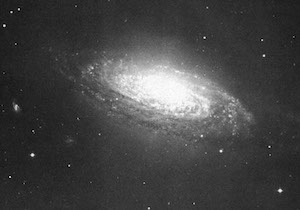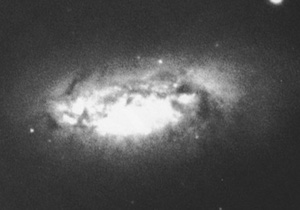Galaxies Still Misbehaving
The latest attempts to "weigh" galaxies are still coming up a bit short. The spiral galaxy, NGC 3521 has a mass equal to the mass of 80 billion Suns. The spiral galaxy NGC 972 has a mass equal to 12 billion Suns. However, when we compare the amount of light coming from those galaxies, it doesn't match the amount of light we would expect from that much matter. It's a puzzle.


Images from Carnegie Atlas of Galaxies (Sandage & Bedke 1994)
Left: Image of NGC 3521 by Las Campanas Observatory's duPont telescope. Right: image of NGC 972 by Palomar Observatory's Hale Telescope.
The amount of starlight coming from the two galaxies is based on careful measurement of each galaxy's total luminosity (brightness), as recorded on photographic plates. It also takes into account the way the stars in each galaxy spread out from the center out to their edges. This distribution varies from galaxy to galaxy.
The mass measurement is based on the same idea that long ago allowed astronomers to calculate the mass of the Sun. Basically, if you have a relatively small mass object orbiting a very large mass object at a known speed, you can work out the large object's mass mathematically. The same physics applies to stars orbiting a galaxy's center of gravity.
To get the speeds of stars the astronomers did not clock them with a stopwatch. Their actual motions are too small to measure with a telescope. Instead, the researchers sampled small areas of starlight from different parts of the galaxies and split the light into spectra – or their rainbows of color. These spectra contain lines that shift in proportion to the speeds the stars are moving. The speed of the stars can then be used to determine the mass of the galaxy the stars are in.
To make comparisons easier, astronomers blend the luminosity and mass measurements into a single number called a mass-to-light ratio which is based on the mass and luminosity of our Sun. Our Sun has a mass of "one solar mass" and a luminosity of "one solar luminosity," so the Sun's mass-to-light ratio is equal to one. A ratio greater than 1, implies more mass than luminosity – which means an object (a galaxy) has more mass than expected.
The NGC 3521 galaxy was studied with the 82 inch telescope at McDonald Observatory at the University of Texas. The results of the study give it a light-to-mass ratio of 4 or greater. This means this galaxy has four times more mass than its light indicates it should have. The mass of the NGC 972 galaxy is closer to what was expected, with a light-to-mass ratio of 1.2. These results were reported in recent issues of Astrophysical Journal by teams of researchers led by Margaret Burbidge at the University of California at San Diego.
These two galaxies are not unique in their "misbehavior." Other researchers are finding galaxies everywhere that have mismatched mass-to-light ratios. So far, no one has offered a clear explanation for this.
About the only consolation these scientists may have is that their missing matter problem is far less extreme than that of astronomer Fritz Zwicky at CalTech University. In 1933 he measured the amount of light from the entire Coma cluster of galaxies. Then he measured the speeds of the galaxies as they orbited the cluster to determine their mass. Zwicky came up with a light-to-mass ratio of about 500. That means 99 percent of the matter there is hidden (not giving off light). At the moment, most astronomers seem content to ignore such extreme numbers, being, as they probably are, astronomical flukes. •



